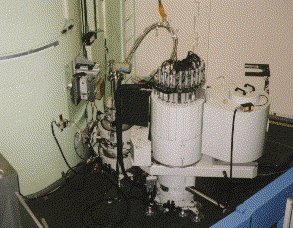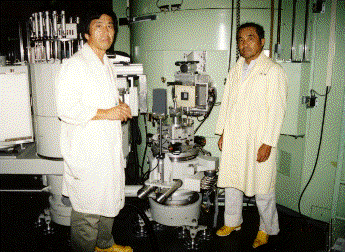Tohoku University Polarizetion Analyzer
Neutron Spectrometer


The TOPAN spectrometer has been in a smooth operation since the previous activity
report.We,however,encountered several unexpected mechanical troubles such as a sudden
stop of the encoder located at the monochrometor gear. Expect some short periods dur-
ing the interruptions due to these problems, we have not spent extra machine time for
further maintenance.We also found a few unsatisfactory performances for the polarizer
as well as the polarization analyzer.In particular,we realyzed that several pieces of
Heusler plates used for the monochromator have poor reflectivity and polarizability.
They are thus not suited for the polarization analyzer,either. We are now in the pro-
cess of practicing the development of Heusler crystal, which we plan to report in de-
tail in the next issue. Our final goal for the TOPAN spectrometer is the realization
of an instantaneous change between the unpolarized-scattering mode and the polariza-
tion-analyzing mode without re-adjusting the sample configuration. In other words, we
can switch to the polarization-analyzing mode whenever a clean separation of the mag-
netic scattering from the total scattering is required. Moreover, this switching fea-
ture must be built in the operating system. Now that the operating system is fully
implemented, we can concentrate on installing a good polarizing crystal.
One of the most important achievement is that we can now operate a cryostat with a
dilution refrigerator(mixed fluid of 3He-4He)on the TOPAN spectrometer.It took several
years until we can reach temperature below 100mK regularly.In order to precisely read
the temperature at the sample position, we are setting thermometers at several stages
in the sample chamber.Our group have been also making efforts to develop a better neu
-tron(unpolarizing) monochromator, particularly by controlling the mosaicity of a cop
-per single crystal with stress.We now understand how to apply the stress in order to
introduce the uniform mosaic structure. The next step is to design the devices which
can apply the uniform stress. We plan to extend this technique for the development of
various monochromator crystals such as Be,Ge and so on.Unfortunately,the international
cooperating project for the Be monochromator development lead by Institut Laue Lange-
vin,in which our group had participated as the Japanese representative,was terminated
because of financial problems. As a result of this cooperation,however,we now hold 14
pieces of Be single crystal rods. We would like to acknowledge both Yamada Science
Foundation and Mitsubishi Foundation for their generous supports and interests for
many years.
Highlights
Since most of the papers we have published are presented here or were summarized in
the last issue, we will just pick up a few of them as highlights of the outcome from
the TOPAN spectrometer.
First of all,we have succeeded in growing high quality single crystals of La2xSrxCuO4,
the so-called 214 superconductor. The highest TC is 37.3 K at the optimal hole doping
concentration with the Sr substitution. With these samples, we could observe a very
clean energy gap in the magnetic excitation, which starts opening just above TC as
shown in Fig.11. The gap energy is estimated at about 11meV from a theoretical calcu
-lation assuming the d wave symmetry by Tanamoto et al.2,who uses the t-J model. This
result is the first evidence of this wave symmetry of the superconducting current in
the 214 crystal.
The second highlight is the spectacular results for chromium. The magnetic excita
-tion in the longitudinal spin-density-wave(SDW)state below 110K shows a three-peaked
structure, where the spin polarization is parallel to the SDW propagation vector. As
shown in Fig.23,the spectrum shows a crossover between low and high energy excitation
-s.The incommensurate scattering at the static SDW wave vector is dominant at low ene
-rgies.At high energies above 25meV,the commensurate scattering at the (100)antiferro
-magnetic superlattice position starts growing.This result reflects the fact that the
scattering intensity shows a similar crossover at the corresponding temperature around
200K. It is worthwhile to note that the magnetic excitation around the antiferromagne
-tic superlattice position(100) remains as high as the energy transfer of 500meV.
The third highlight is the spin correla tion in La2NiO4+d, where d represents the
concentration of the excess oxygen ions.As presented in the last issue,we have estab-
lished the phase diagram of La2NiO4+d and we can readily prepare the samples contain
-ing only the single phase.The thermal evolution of the spin correlation shows a dram
-atic d dependence, which is far deferent from that of the light doping cuprate cryst
-als. We have conjectured that doped holes are partly localized in the Ni d band and
partly go into the oxygen p band,whereas all the doped halls in the cuprate enter the
oxygen p band.
Finally, we would like to mention the critical exponents measured for a CoS2 single
crystal. CoS2 is recognized as a typical itinerant ferromagnet which agree well with
a theoretical calculation for the Heisenberg ferromagnet.The result we obtained urges
us to reconsider the electron correlation effects in CoS2.

Contact person : Yasuo ENDOH(right) Kazuyoshi YAMADA(left) Faculty of Science,Tohoku University